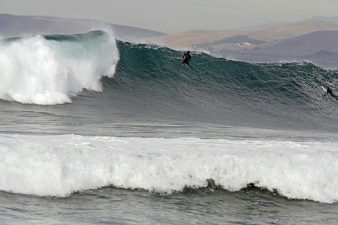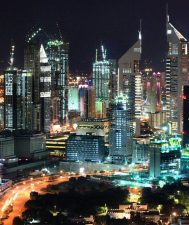 Ocean bricks are underwater infrastructure for wind turbines and more futuristic ideas.
Ocean bricks are underwater infrastructure for wind turbines and more futuristic ideas.
Here’s a business that might do really well in the future. Israeli inventors Yoram Alkon and Dr. Eli Kent have come up with a giant “ocean brick” concept that would have many uses in the strange new world that we are inadvertently creating – a world of rising sea levels, sinking aquifers, flooding wetlands and melting permafrost.
Their invention is simple. A scalable, modular building block with a largely hollow base that can be used to meet many needs for support upon which to build a kind of artificial land, wherever needed, on both land and sea.
As municipalities have to invest in protection from rising sea levels in a future climate-changed world, units can be put in place over time as bases upon which to erect new quay walls, breakwaters and sea walls. As seas rise higher, more can be always be added later on top, because it is modular.
Since the top surface is walkable, it can form bases upon which to construct artificial islands.
For lowlands susceptible to flooding, such as New Orleans and the Netherlands, the mostly hollow structure can be used to stabilize soils. In a world in which we deplete our aquifers, and sinkholes develop, as in the Dead Sea, and parts of the Ogalla aquifer throughout the US, it can be used to provide a firm footing on soft soils. On land becoming destabilized as permafrost melts, as in Alaska and Siberia, it can serve the same need for stability.
It is strong enough to be drivable, so it also can be used to create a giant base to harness energy from further and further out to sea. For the energy industries, it can be easily towed out to sea and sunk, and piled up to build an oil platforms for off-shore oil and gas drilling (and Israel just uncovered the mother of all gas fields off its shoreline) and it could also be used in the same way to build the base to support off-shore wind platforms, or used underwater for housing tidal generators embedded in the round holes. Each hole is 6 meters – or about 18 feet across.
The base is formed of hollow concrete precast modules, with a built-in solid section of a truss in the form of a tetra-hedron: a polyhedron composed of four triangular faces. This makes it very strong, with the minimum of material used, so it is lighter weight. The modules can be piled up like cubes, and then can be interconnected to create a buoyant, stiff, light and strong superstructure.
The tetra-hedron design cuts out 92% of the filling material normally needed, and in marine environments it can serve the sea fauna as habitat/sanctuary, manmade reef and fish enhancer, making it an environmentally friendly concept, both in material use, and in fish-friendliness. Because it is largely hollow spaces, it is very friendly to marine life; barnacles and shellfish actually love these kinds of “hole-y” structures to build homes on. It is one reason that a Swedish study found that off-shore wind power actually increased marine life around its bases.
These modular mega-structures are very versatile, with a myriad of uses in a world of increasing carbon constraints and changing climates.
Related stories:





